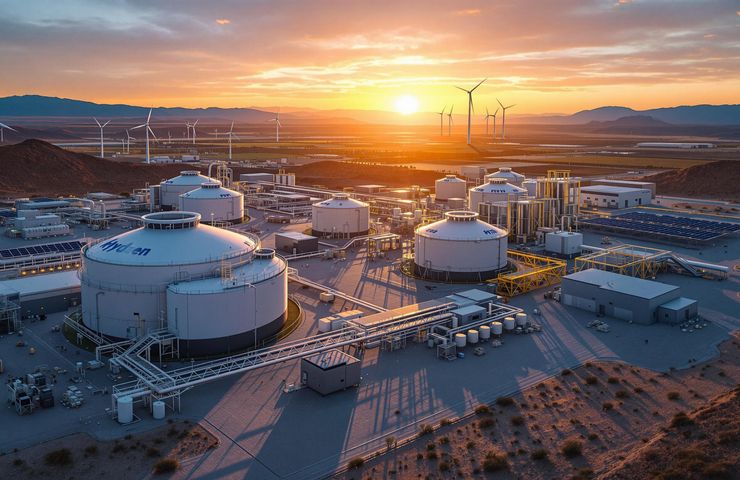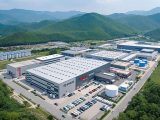
Hydrogen Production: Air Liquide’s $250M Liquid Hydrogen Plant in Nevada
August 5, 2025When you think of the Nevada desert, you probably picture endless dunes and sun-baked rock. Now swap that image with a network of cryogenic tanks and hydrogen piping. Air Liquide just fired up the world’s largest (at the moment) liquid hydrogen production plant in North Las Vegas, Nevada. With a hefty 30 tons-per-day capacity, this facility is a game-changer for scaling up green hydrogen at industrial levels.
It’s a $250 million show of confidence in hydrogen production as a cornerstone of the energy transition. Founded back in 1902, the French giant has over six decades of hydrogen know-how under its belt and sits right behind the top spot among global industrial gas suppliers. By planting this massive hub in the U.S. Southwest, Air Liquide isn’t just fueling its own clean-energy goals; it’s also backing California’s push under the Low Carbon Fuel Standard.
Plant Overview
Perched in the parched heart of Nevada, the plant drinks up the region’s abundant solar juice and taps into existing logistics lanes. Located less than 300 miles from California, it can ship liquid hydrogen efficiently to the Golden State’s industrial centers and big cities. Spread across a sprawling site, you’ll find rows of electrolyzers, storage tanks, and liquefaction units, all laid out with future growth in mind.
Air Liquide has been a hydrogen trailblazer for more than 60 years, operating everything from small refueling stations to continental pipeline networks. The North Las Vegas plant stitches those bits and pieces together into a gigawatt-scale operation. It’s a clear signal that large-scale, low-carbon hydrogen is vital for decarbonizing both transport and heavy industry.
Clean Technology at Work
At the heart of the process sits electrolysis, where renewable electricity—pulled from nearby wind and solar farms—splits water into hydrogen and oxygen. No smoke, no mirrors, no direct CO₂ emissions. That’s why policymakers and clean-energy advocates are cheering on this route as the gold standard for renewable hydrogen.
But it doesn’t stop there. The plant also taps into renewable natural gas (RNG) from organic waste streams. By blending RNG with electrolytic hydrogen, Air Liquide hits California’s strict low-carbon benchmarks and keeps the taps flowing even when the sun dips or the wind calms down. It’s a clever hybrid approach that trumps purely electrolytic setups when it comes to reliability.
Once the hydrogen’s made, it’s chilled to near absolute zero—around –253 °C—in state-of-the-art liquefaction units. This phase change crams more energy into less volume, making it practical to haul massive quantities to distant markets. High-tech insulation and advanced materials keep boil-off to a bare minimum, and on-site storage tanks hold days’ worth of supply, smoothing out demand spikes and keeping customers happy.
Driving Industry and Mobility
In California, fuel cell buses, trucks, and cars are already cruising the streets, and this plant can support over 40,000 fuel cell vehicles—almost doubling today’s fleet. For fleet managers, that spells predictable hydrogen pricing and rock-solid supply, two big hurdles that have slowed broader adoption of fuel cell technology in heavy-duty transport.
Beyond the highways, industries like glassmaking, electronics cleanrooms, and petroleum refining lean heavily on hydrogen as a feedstock. Swapping out gray hydrogen for a renewable-based supply can slash upstream emissions, helping these sectors hit tightening environmental regs. By serving both mobility and industrial needs, the plant maximizes its utilization, proving how versatile and vital hydrogen can be.
Economic and Environmental Impact
Building and running such a high-tech facility brings plenty of local perks. During construction, roughly 700 jobs sprang up, and now about 25 permanent positions keep the plant humming—from operators to engineers and maintenance crews. Local contractors, equipment makers, and suppliers get a slice of the action, too, diversifying an economy long tied to entertainment and mining.
On the environmental front, switching from gray hydrogen (the kind made from natural gas without carbon capture) to a renewables-first model chops an estimated 200,000 tons of CO₂ per year. That’s like taking nearly 50,000 gas-guzzling cars off the road. As states and companies race toward net zero by mid-century, projects like this one offer a real, scalable pathway to decarbonize the toughest sectors.
Strategic Implications
Going from pilot-scale demos to a 30 ton/day commercial outfit isn’t child’s play. By hitting this milestone, Air Liquide is raising the bar for peers and regulators eyeing future projects. Success here could unlock fresh investments in pipelines, refueling stations, and end-use equipment—sparking a virtuous cycle of demand and supply that drives the hydrogen infrastructure forward.
With federal infrastructure cash and state incentives flowing, the U.S. is jockeying for leadership in clean hydrogen. Nevada’s plant gives Air Liquide a first-mover edge, but rivals like Linde, Plug Power, and regional utilities are quick on its heels. The real showdown will come down to cost curves, policy certainty, and the ability to integrate renewable hydrogen at scale. It’s a high-stakes match with global ramifications.
Looking Ahead
If you’re tracking the energy transition, this project is full of lessons. Pairing abundant renewables with cutting-edge liquefaction and weaving the output into both transport and industry creates a blueprint you could copy in sun-drenched corners of Australia or the Middle East. Getting more public-private teamwork and faster permitting processes will be key to speeding up these follow-on projects.
At the end of the day, the North Las Vegas plant isn’t just a feather in Air Liquide’s cap; it’s proof that large-scale, low-carbon hydrogen is not only feasible—it’s economically savvy. As demand for zero-emission solutions surges, expect more deserts, ports, and industrial zones to morph into epicenters of hydrogen production. And when that future arrives, we’ll have this project to thank for lighting the way.



 With over 15 years of reporting hydrogen news, we are your premier source for the latest updates and insights in hydrogen and renewable energy.
With over 15 years of reporting hydrogen news, we are your premier source for the latest updates and insights in hydrogen and renewable energy.